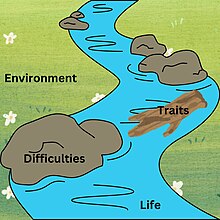
The Kawa model is a culturally responsive conceptual framework used in occupational therapy to understand and guide the therapeutic process.[1] Developed by Japanese occupational therapists (OTs), the model draws upon the metaphor of a river to describe human occupation, which according to OTs refers to individuals' daily activities that make life meaningful. The overarching goal of the model is to "provide a culturally flexible model to aid occupational therapists to improve communication with clients, to better understand what a client finds meaningful and important, and to design optimal client-centered interventions."[2]: 17
In Japanese, kawa (かわ) means river, and the model uses the metaphor of a river to represent a person's life flow or occupational journey. The river represents the dynamic and ever-changing nature of life, while rocks, debris, and other elements in the river symbolize obstacles, challenges, and personal experiences. The model emphasizes that each person's river is unique and influenced by cultural, social, and personal factors.
The Kawa model incorporates five main elements: water, river banks and space, rocks, and driftwood. In the model, "water (mizu) represents life flow and health, driftwood (ryuboku) represents personal assets and liabilities, rocks (iwa) represent life circumstances and problems, and the river walls (torimaki) represent physical and social environmental factors."[1]: 1
- ^ a b Ober, Jayme; Newbury, Rebecca; Lape, Jennifer (2022-04-15). "The Dynamic Use of the Kawa Model: A Scoping Review". The Open Journal of Occupational Therapy. 10 (2): 1–12. doi:10.15453/2168-6408.1952. ISSN 2168-6408. Archived from the original on 2023-04-24. Retrieved 2023-05-27.
- ^ Cite error: The named reference
:5was invoked but never defined (see the help page).